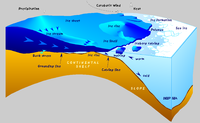
Photo from wikipedia
Abstract Antarctic coastal polynyas serve as crucially-important sea-ice “factories” and are (in certain cases) of global significance as sites of Antarctic Bottom Water (AABW) formation e.g., the Cape Darnley Polynya… Click to show full abstract
Abstract Antarctic coastal polynyas serve as crucially-important sea-ice “factories” and are (in certain cases) of global significance as sites of Antarctic Bottom Water (AABW) formation e.g., the Cape Darnley Polynya (CDP) in East Antarctica. As such, understanding change and variability in their behaviour, and the factors responsible, is a high priority in climate (change) science. One such important factor that is both poorly understood and quantified is their linkage with adjacent landfast sea ice (fast ice). Here, we present a first detailed analysis that identifies and quantifies key linkages between the dynamics/behaviour of the CDP and fast ice. By forming a barrier to the incursion of pack ice at the eastern boundary, fast ice immediately upstream of the CDP (associated with the distribution of grounded icebergs) plays a crucially-important role in the polynya formation, maintenance and variability. This satellite data-based study builds upon earlier conceptual work on polynya-fast ice feedback mechanisms in the Mertz Glacier region by showing that statistical estimation of the rates of sea ice production (and hence AABW formation) in the CDP is significantly improved through inclusion of two key fast-ice metrics, compared to use of atmospheric covariates alone. These two metrics are the meridional extent of fast ice upstream of the polynya and total fast ice area within the region of high sea ice production. The work highlights the importance of accurate representation of the coupled Antarctic coastal polynya-fast ice system in global climate models.
Journal Title: Remote Sensing of Environment
Year Published: 2019
Link to full text (if available)
Share on Social Media: Sign Up to like & get
recommendations!